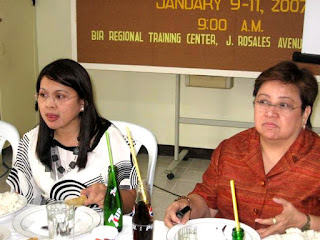
Authorities said at least four houses were buried midnight last Wednesday.
Rescuers are looking for Faustino Pungcol, Rosita Kadisal, Bert Triwalan, Nelo Galeria, Nitoy Galeria, and two others whose identities were unclear at presstime.

CAGAYAN de Oro Journal (BEN BALCE/Jan 18) - Bureau of Internal Revenue (BIR) Revenue District No. 105 based in Surigao City headed by Revenue District Officer (RDO) Satar Laguindab said, the district has overshot its target collection goal for 2006. For the last four years, the district was able to overshoot its assigned goal.
"The district continuously stepped up collection efforts for the last four years," said Laguindab adding, "the increased collections every year not only helped our district target but also boosted the region's target collection."
Laguindab said, the district collection target for 2006 was P400, 670, 000 and the district collected as of January 11, the amount of P424,548,329.38; an increase of P23,878,329.38 which is 5.96 percent more and almost 50 percent higher than the 2005 collection goal of P265,670,000.
BIR regional office here through its cumulative report since 2003 showed that all districts overshot their individual collection targets.
"RD No. 105 in Surigao maintained increased collections against its collection target even much higher compared to other districts," said BIR Revenue Region No. 17 regional director Tamanatao Amerol.
Amerol said, all districts contributed in no small measure to the Region’s over-all good performance which posted a 15.61 percent increase in actual collections by collecting P1,620,734,770.87 against their collection goal of P1,578,359,000; an increase of P42,375,770.87 or 15.61 percent against the previous year's actual collections.
The BIR Caraga-region oversees the revenue collections efforts of four regional district offices, namely: Butuan-based RD 103 headed by regional district officer (RDO) Edilberto Radaza; RD 104 headed by RDO Lordel Monteclaro based in Bayugan, Agusan del Sur; and RD 106 headed by RDO Marcelino L. Yap based in Tandag, Surigao del Sur.
The revenue collection performance report for year 2006 furnished on this paper showed the following data: RD 103 – Butuan City posted an increased collection for 2006 increase of 3.53 percent; RD 104 Bayugan, Agusan del Sur posted a 3.53 percent increase; RD 105 Surigao City, an increase of 5.96 percent and RD 106 Tandag, Surigao del Sur with an increase of 1.78 percent.
Amerol said, the tax collection performance is largely boosted by the ongoing tax education and information campaign coupled with the various measures and strategies being implemented by every district revenue office in the region aimed to exceed their respective target collection goals.
All revenue district offices have exceeded its target collections over last year's (2005) collections.
"The biggest collection was made by Surigao City district revenue office under the leadership of Laguindab," Amerol said.
Second highest is RD No. 104 based in Bayugan, Agusan del Sur under RDO Lordel Monteclaro with actual tax collections of P275,233,854.43 or an increase of 3.53 percent with the amount of P9,390,854.43.
Butuan City revenue district office under RDO Edilberto Radaza also exceeded its target goal for 2006 amounting to P4,452,948.03 from its target collections of P627,003,000 after Radaza collected P631,455,948.03.
Tandag, Surigao del Sur revenue district office under RDO Marcelino Yap also exceeded by 1.78 percent (2006) totaling P5,081,582.02.
Amerol said, the BIR Commissioner has ordered all Regional Directors throughout the country to sustain the effort in the government's drive against tax evasion following his warning to other businessmen and firms that BIR would never countenance tax evasion as it is considered a "crime against the people."
Home

 BUTUAN City (BEN BALCE/Jan. 16) - THE Bureau of Internal Revenue in Caraga region, covering the four provinces of the area, has exceeded its collection goal for 2006 of P1,578,359,000 by 15.61 percent. The total collections in the amount of P1,620,734,770.87 for the current year is P42,375,770.87 more than the target.
BUTUAN City (BEN BALCE/Jan. 16) - THE Bureau of Internal Revenue in Caraga region, covering the four provinces of the area, has exceeded its collection goal for 2006 of P1,578,359,000 by 15.61 percent. The total collections in the amount of P1,620,734,770.87 for the current year is P42,375,770.87 more than the target. His colleagues attest that Yap, a relatively new-comer in Tandag who assumed his post last year, made waves when he posted an increase in his revenue collections surpassing his district's collection goal of P284,843,000 for 2006 by his actual collection of P289,924, 852.02; an increase of P5,081,582.02 or 1.78 percent more.
His colleagues attest that Yap, a relatively new-comer in Tandag who assumed his post last year, made waves when he posted an increase in his revenue collections surpassing his district's collection goal of P284,843,000 for 2006 by his actual collection of P289,924, 852.02; an increase of P5,081,582.02 or 1.78 percent more. 